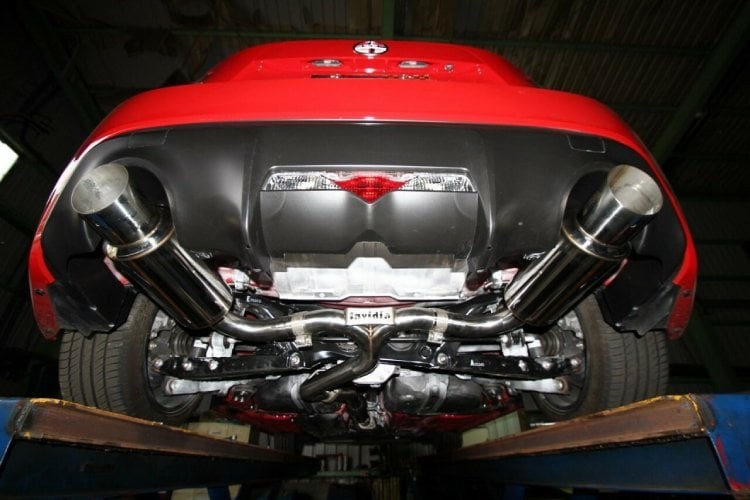Pros & Cons Of Having A Loud Car
Before exploring how to amplify your car’s exhaust note, it’s crucial to consider the advantages and disadvantages of modifying your vehicle for a louder sound.
Pros
Let’s begin with the positives of increasing your car’s exhaust volume. What benefits can you expect from this type of modification?
Firstly, and perhaps most appealing to car enthusiasts, is the enhanced sound. A modified exhaust can transform the engine’s sound into a more aggressive and sporty tone, often described as a symphony for automotive ears. This auditory upgrade can significantly increase driving pleasure, especially for those who appreciate the roar of a powerful engine.
Beyond the sound, performance improvements are another potential advantage, particularly when considering modifications like straight-pipe exhausts or performance headers. These changes can optimize engine performance by improving exhaust gas flow.
How do these modifications enhance performance? By reducing restrictions in the exhaust system. Removing components like the catalytic converter, stock exhaust manifold, and resonator allows exhaust gases to exit the combustion chamber more freely. This improved airflow can lead to horsepower gains, ranging from 10 to 50 horsepower depending on the engine size and the extent of the modifications. Larger displacement engines typically experience more significant gains.
Cons
Now, let’s address the downsides of making your car louder before we delve into the methods. What are the potential drawbacks of such modifications?
The most immediate con is noise pollution. Increased exhaust volume can be disruptive to others and may lead to conflicts with neighbors and law enforcement. It’s essential to familiarize yourself with local noise ordinances and regulations, as excessively loud vehicles can result in fines and legal issues.
Another downside is increased cabin vibration. Stock mufflers and resonators are designed not only to reduce noise but also to minimize vibrations within the car. Removing or modifying these components can lead to noticeable and potentially uncomfortable vibrations inside the vehicle.
Furthermore, modifications can trigger the check engine light. More complex exhaust modifications may require an engine control unit (ECU) tune to adjust oxygen sensor readings and ensure proper engine operation. Without proper tuning, the car’s computer may detect abnormalities and activate the check engine light.
Emissions are another significant concern. Modifying the exhaust system, especially by removing catalytic converters, drastically increases harmful emissions. This can lead to failing emissions tests, as the car no longer meets factory-recommended emission standards. Higher emissions also contribute to a larger carbon footprint, which is an environmental consideration for responsible car enthusiasts.
With these pros and cons in mind, let’s now explore the various methods to make your car exhaust louder, allowing you to make informed decisions about modifying your vehicle.
How To Make Your Car Louder – The Various Methods
Now, let’s delve into the practical aspects of how to increase your car’s exhaust volume. In the following sections, we will outline the most common methods car enthusiasts use to achieve a louder exhaust note. From simple bolt-on modifications to more involved system changes, we’ll cover a range of options to suit different budgets and mechanical skill levels. Let’s explore the modifications you can undertake to amplify your vehicle’s sound.
1. Install a Cold Air Intake
The first method to explore for increasing your car’s sound is installing a cold air intake system. This modification, while primarily designed for performance gains, also contributes to a more aggressive engine sound.
What exactly is a cold air intake? It’s an aftermarket air filter system designed to draw cooler air into the engine. It typically replaces the factory air box and paper filter with a less restrictive, often cone-shaped filter and intake tube.
The key difference lies in the design and function. Cold air intakes are engineered to maximize airflow to the engine. The cone shape of the filter increases surface area, allowing for greater air intake. Many systems also incorporate heat shields or relocate the filter away from the hot engine bay to ensure cooler, denser air enters the engine. Cooler air is denser and contains more oxygen, which can improve combustion efficiency and power output.
Beyond performance gains, a cold air intake significantly alters the engine’s sound. As the engine draws in more air through a less restrictive intake, it produces a more pronounced and aggressive induction noise, particularly under acceleration. This sound is often described as a louder, deeper growl or roar, which is very satisfying for many car enthusiasts.
While primarily an intake modification, the increased airflow and enhanced engine sound from a cold air intake can make the exhaust note seem louder and more pronounced, contributing to the overall perception of a louder car.
For optimal performance with a cold air intake, some vehicles may benefit from an ECU tune. This ensures that the engine’s air-fuel mixture and timing are properly adjusted to take full advantage of the increased airflow. Some aftermarket cold air intake kits even include a pre-programmed tuner for easier installation and setup.
2. Install an Exhaust Tip (Backbox)
Another accessible way to modify your car’s sound is by installing an aftermarket exhaust tip, often referred to as a backbox. This is one of the simplest and most budget-friendly exhaust modifications available.
What is an exhaust tip? It’s essentially the visible end piece of your exhaust system, typically mounted at the very rear of the car, after the muffler. While primarily cosmetic, aftermarket exhaust tips can also subtly influence the exhaust sound.
Aftermarket exhaust tips come in various shapes, sizes, and materials, allowing for customization of the car’s rear appearance. Beyond aesthetics, the design of the exhaust tip can affect the sound resonance and tone. Larger diameter tips or tips with specific internal designs can slightly amplify or deepen the exhaust note.
While the sound difference from just an exhaust tip alone might not be dramatic, it can contribute to a more noticeable and pleasing exhaust sound, especially at lower engine speeds and idle. The effect is often subtle but can enhance the overall auditory experience of the car.
The effectiveness of exhaust tips in altering sound can vary. Generally, higher-quality, more elaborately designed tips tend to produce a more noticeable and refined sound change compared to basic, inexpensive tips. As with many aftermarket parts, “you get what you pay for” often applies in terms of sound enhancement from exhaust tips.
3. Aftermarket Headers
For a more significant increase in exhaust volume and a change in exhaust tone, consider installing aftermarket exhaust headers. This modification is more involved than exhaust tips but offers a more substantial impact on sound and performance.
Aftermarket headers replace the factory exhaust manifolds, which are the first part of the exhaust system connected to the engine. Stock manifolds are often designed for efficiency and emissions control, which can restrict exhaust flow and muffle sound.
Aftermarket headers are engineered to improve exhaust flow, typically featuring wider diameter tubing and smoother bends. They are often constructed from higher-quality materials like stainless steel for better durability and heat resistance. By reducing exhaust backpressure, headers can improve engine performance and fuel efficiency, in addition to altering the sound.
Installing aftermarket headers can dramatically change the exhaust note. They generally produce a louder, more aggressive, and often higher-pitched exhaust sound compared to stock manifolds. The removal of the catalytic converter, which is often integrated into the stock manifold, further contributes to the increased volume and change in tone.
While pre-made, bolt-on headers are available, installation can still be more complex than other exhaust modifications. It often requires removing various engine components and potentially dealing with oxygen sensor placement or modifications. Due to the removal of catalytic converters, this modification will affect vehicle emissions and may not be legal in all locations for street use.
This modification is particularly popular for older or classic cars where emissions regulations may be less stringent or for vehicles primarily used for track or off-road purposes. For modern vehicles, it’s crucial to consider the legal and environmental implications of removing catalytic converters.
4. Rear Muffler Delete
A more direct approach to significantly increase exhaust volume is a rear muffler delete. The rear muffler is the final component in the exhaust system, specifically designed to dampen sound. Removing it results in a much louder exhaust.
The rear muffler is essentially a large sound-absorbing box located at the tail end of the exhaust system. Its purpose is to reduce exhaust noise to meet legal requirements and comfort standards. Deleting the rear muffler bypasses this sound dampening, allowing exhaust gases to exit with minimal restriction.
A rear muffler delete is typically achieved by cutting out the muffler and replacing it with a straight pipe section. This is a relatively simple and inexpensive modification that yields a dramatic increase in exhaust volume. The resulting sound is significantly louder and more aggressive, often with a raw and unrefined tone.
While effective in making a car louder, a complete muffler delete can be excessively loud for daily driving and may attract unwanted attention from law enforcement. The sound can also be droning and uncomfortable on longer journeys.
To mitigate the extreme loudness of a full muffler delete, some enthusiasts opt for a modified approach. Instead of completely removing the muffler, they may replace it with a shorter, less restrictive muffler or simply weld in a section of exhaust tubing in place of the large stock muffler. This can provide a louder and more aggressive sound than stock while retaining some level of sound control compared to a complete muffler delete.
It’s important to be aware of local noise regulations before performing a muffler delete, as it can easily exceed legal noise limits in many areas.
5. Performance Muffler
For a balance between increased sound and refined tone, upgrading to a performance muffler is a popular option. Performance mufflers are designed to be less restrictive than stock mufflers, allowing for a louder and sportier exhaust note without the extreme volume of a muffler delete.
Performance mufflers are aftermarket mufflers engineered to enhance exhaust sound and potentially improve performance. They are typically designed with less sound-deadening material and a less restrictive internal path for exhaust gases compared to stock mufflers.
Replacing the stock muffler with a performance muffler is a straightforward modification. It usually involves unbolting or cutting out the old muffler and welding or bolting in the new performance muffler in its place. This is a reversible modification, as the stock muffler can be reinstalled if desired.
Performance mufflers come in a wide variety of styles and sound levels. Some offer a mild increase in volume with a deeper tone, while others are designed for a significantly louder and more aggressive sound. Brands often provide sound clips or decibel ratings to help customers choose a muffler that matches their desired sound level.
A key advantage of performance mufflers is that they offer a more controlled and often more refined sound compared to muffler deletes or drilling holes in the exhaust. They are designed to produce a pleasing and sporty exhaust note without being excessively loud or obnoxious. Furthermore, unlike modifications that remove catalytic converters, performance mufflers are generally emissions-legal and won’t trigger check engine lights.
6. Install X-Pipe
For vehicles with V-engines (V6 or V8), installing an X-pipe is a method to enhance both exhaust sound and performance. An X-pipe replaces the stock mid-muffler or resonator with a specially designed pipe that merges the exhaust flow from both banks of the engine.
An X-pipe is a section of exhaust tubing designed in an “X” shape, where the exhaust flow from each side of a V-engine is directed to pass through the center of the “X” before exiting. This merging of exhaust pulses is believed to improve exhaust flow and scavenging, potentially increasing horsepower and torque.
Installing an X-pipe typically involves cutting out the existing mid-muffler or resonator and welding or clamping the X-pipe in its place. This modification is more common on vehicles with dual exhaust systems, which are typical of V-engines.
The X-pipe alters the exhaust sound by changing the way exhaust pulses interact. It is often described as creating a smoother, higher-pitched, and more exotic exhaust note, particularly for V8 engines. It can also reduce raspiness and drone compared to other exhaust modifications.
While primarily known for its sound and performance benefits on V-engines, X-pipes can also be used on inline engines in some dual exhaust setups. They are a popular choice for enthusiasts seeking a distinctive and refined exhaust sound from their V-engine vehicles.
7. Drill Holes
One of the most rudimentary and least recommended methods to make your car louder is drilling holes in the exhaust system. This involves physically drilling holes into the muffler or exhaust pipes to create exhaust leaks and increase volume.
Drilling holes in the exhaust is a crude and generally frowned-upon method of increasing exhaust volume. It directly creates leaks in the exhaust system, allowing exhaust gases to escape prematurely and increasing noise.
This method is typically implemented by drilling small holes into the muffler or exhaust piping. The size and location of the holes will affect the volume and tone of the exhaust. More holes or larger holes will result in a louder exhaust.
While drilling holes is a very cheap and easy way to make a car louder, it comes with significant drawbacks. The resulting sound is often described as raspy, tinny, and unpleasant, lacking the refined tone of other exhaust modifications. It can also create excessive backpressure and potentially harm engine performance in the long run.
Furthermore, drilling holes is considered unprofessional and can damage the exhaust system. It can also lead to exhaust leaks, which are not only noisy but also potentially dangerous, allowing harmful exhaust fumes to enter the cabin. This method is strongly discouraged due to its negative impact on sound quality, potential performance issues, and unprofessional nature.
8. Cherry Bomb
For a retro and aggressively loud exhaust sound, consider installing a cherry bomb muffler. Cherry bombs are a type of glasspack muffler known for their loud and resonant exhaust note, popular in hot rod and classic car culture.
A cherry bomb is a type of muffler characterized by its bright red color and straight-through glasspack design. Glasspack mufflers consist of a perforated or louvered core surrounded by fiberglass packing material. This design offers minimal restriction to exhaust flow, resulting in a loud and free-flowing exhaust sound.
Cherry bomb mufflers are typically installed as a replacement for the stock muffler. They can be welded or clamped into the exhaust system. Due to their straight-through design and minimal sound dampening, cherry bombs produce a very loud and resonant exhaust note.
The sound of a cherry bomb is often described as deep, throaty, and aggressive. It is significantly louder than stock mufflers and even many performance mufflers. While they are effective at increasing volume, cherry bombs are often criticized for prioritizing loudness over tone refinement. The sound can be boomy and lack the nuanced tone of more sophisticated performance mufflers.
Cherry bombs are a popular choice for those seeking a loud and attention-grabbing exhaust sound, particularly for classic cars, hot rods, and trucks. However, their extreme loudness may not be suitable for daily drivers or areas with strict noise regulations.
9. Straight Pipe
The most extreme method for maximizing exhaust volume is installing a straight pipe exhaust system. A straight pipe exhaust eliminates all mufflers and resonators, providing the least restricted and loudest possible exhaust sound.
A straight pipe exhaust system replaces the entire exhaust system from the catalytic converter back (or sometimes from the headers back) with straight, un-muffled pipes. This means removing all mufflers, resonators, and any other sound-dampening components.
Straight pipe exhausts can be fabricated by cutting out the existing mufflers and resonators and replacing them with sections of exhaust tubing. Alternatively, complete aftermarket straight pipe exhaust kits are available for some vehicles. Installation can range from relatively simple bolt-on kits to more complex welding and fabrication.
The result of a straight pipe exhaust is the absolute maximum exhaust volume achievable. The sound is extremely loud, raw, and aggressive, with no muffling or sound control. Straight pipes produce a very prominent exhaust note that is hard to ignore.
While straight pipes offer the loudest possible exhaust, they are generally not recommended for street-driven vehicles. They are often excessively loud, potentially illegal in many areas, and can be uncomfortable for daily driving due to the extreme noise levels. Straight pipe exhausts are primarily used for off-road, track, or competition vehicles where maximum sound and performance are prioritized over noise regulations and daily driving comfort.
Conclusion
In this guide, we’ve explored various methods to make your car exhaust louder, ranging from simple modifications like exhaust tips to more extreme measures like straight pipes. Each method offers a different level of sound enhancement, cost, and complexity.
When considering making your car louder, it’s crucial to weigh the pros and cons carefully. While a louder exhaust can enhance the driving experience for enthusiasts and potentially improve performance, it also comes with drawbacks like noise pollution, potential legal issues, and increased cabin vibration.
For beginners or those seeking a subtle increase in sound, starting with options like aftermarket exhaust tips or performance mufflers is recommended. These modifications are relatively easy to install and offer a noticeable improvement in sound without being excessively loud.
More complex modifications like headers, straight pipes, and muffler deletes should be approached with caution and are often best left to experienced DIYers or professional mechanics. These modifications can offer significant increases in volume and performance but also require more technical expertise and may have legal and environmental implications.
Ultimately, the best method for making your car exhaust louder depends on your individual preferences, budget, mechanical skills, and local regulations. Always prioritize responsible car modification and consider the impact on your neighbors and the environment.


